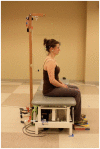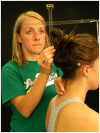Reliability and validity of cervical position measurements in individuals with and without chronic neck pain
- PMID: 26917936
- PMCID: PMC4727731
- DOI: 10.1179/2042618614Y.0000000070
Reliability and validity of cervical position measurements in individuals with and without chronic neck pain
Abstract
Objectives: The cervical range of motion device (CROM) has been shown to provide reliable forward head position (FHP) measurement when the upper cervical angle (UCA) is controlled. However, measurement without UCA standardization is reflective of habitual patterns. Criterion validity has not been reported. The purposes of this study were to establish: (1) criterion validity of CROM FHP and UCA compared to Optotrak data, (2) relative reliability and minimal detectable change (MDC95) in patients with and without cervical pain, and (3) to compare UCA and FHP in patients with and without pain in habitual postures.
Methods: (1) Within-subjects single session concurrent criterion validity design. Simultaneous CROM and OP measurement was conducted in habitual sitting posture in 16 healthy young adults. (2) Reliability and MDC95 of UCA and FHP were calculated from three trials. (3) Values for adults over 35 years with cervical pain and age-matched healthy controls were compared.
Results: (1) Forward head position distances were moderately correlated and UCA angles were highly correlated. The mean (standard deviation) differences can be expected to vary between 1·48 cm (1·74) for FHP and -1·7 (2·46)° for UCA. (2) Reliability for CROM FHP measurements were good to excellent (no pain) and moderate (pain). Cervical range of motion FHP MDC95 was moderately low (no pain), and moderate (pain). Reliability for CROM UCA measurements was excellent and MDC95 low for both groups. There was no difference in FHP distances between the pain and no pain groups, UCA was significantly more extended in the pain group (P<0·05).
Discussion: Cervical range of motion FHP measurements were only moderately correlated with Optotrak data, and limits of agreement (LOA) and MDC95 were relatively large. There was also no difference in CROM FHP distance between older symptomatic and asymptomatic individuals. Cervical range of motion FHP measurement is therefore not recommended as a clinical outcome measure. Cervical range of motion UCA measurements showed good criterion validity, excellent test-retest reliability, and achievable MDC95 in asymptomatic and symptomatic participants. Differences of more than 6° are required to exceed error. Cervical range of motion UCA shows promise as a useful reliable and valid measurement, particularly as patients with cervical pain exhibited significantly more extended angles.
Keywords: Cervical position; Cervical range of motion device; Cervical spine; Criterion validity; Posture; Reliability.
Figures







References
-
- Rossignol AM, Morse EP, Summers VM, Pagnotto LD. Video display terminal use and reported health symptoms among Massachusetts clerical workers. J Occup Med. 1987;29:112–8. - PubMed
-
- Szeto GP, Straker L, Raine S. A field comparison of neck and shoulder postures in symptomatic and asymptomatic office workers. Appl Ergon. 2002;33:75–84. - PubMed
-
- Szeto GP, Straker LM, O'Sullivan PB. A comparison of symptomatic and asymptomatic office workers performing monotonous keyboard work–2: neck and shoulder kinematics. Man Ther. 2005;10:281–91. - PubMed
-
- Haughie L, Fiebert I, Roach K. Relationship of forward head posture and cervical backward bending to neck pain. J Man Manip Ther. 1995;3:91–7.
-
- Shiau YY, Chai HM. Body posture and hand strength of patients with temporomandibular disorder. J Craniomandibular Pract. 1990;8:244–51. - PubMed
LinkOut - more resources
Full Text Sources
Other Literature Sources
Miscellaneous
